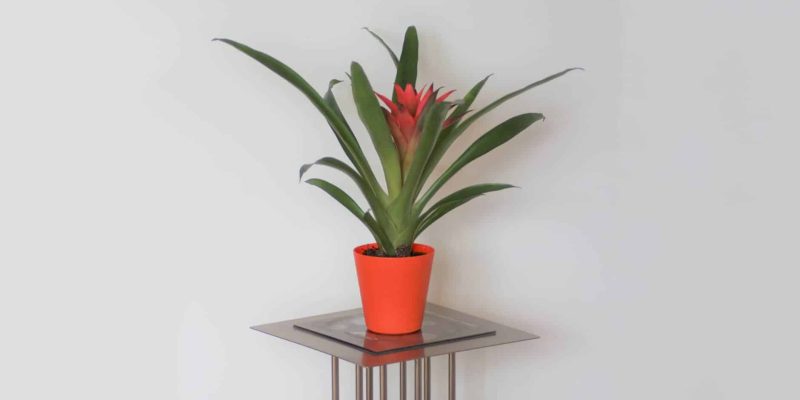Guzmania lingulata, or as it’s commonly called, scarlet star, is the life of the party in the houseplant world. This bromeliad beauty sports flashy, bright red bracts that rise majestically above dark green, strap-like leaves, creating the perfect focal point for any room.
Despite its exotic appearance, Guzmania lingulata care is surprisingly easy, making it ideal for newbie plant parents and seasoned green thumbs alike.
Ready to welcome this lovely tropical plant into your home? Read on to learn everything you need to know about choosing, growing, and caring for your very own scarlet star.
Table of Contents
Guzmania Lingulata Plant Care Guide
History, Habitat, and Characteristics
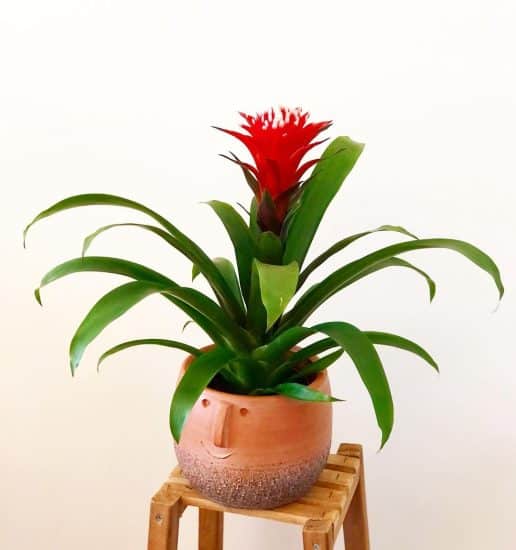
Guzmania lingulata, a member of the bromeliad family, is as captivating as it is easy maintenance. Originally from the lush rain forests of Central and South America, this beauty isn’t your average houseplant — it’s got some horticultural quirks.
Guzmania lingulata’s claim to fame starts with its looks. Sporting glossy green foliage and breathtaking flower heads in hues like red, orange, yellow, pink, and plum, this stunner is hard to miss. Peek a little closer, and you’ll find delicate white flowers hiding in the vibrant bracts.
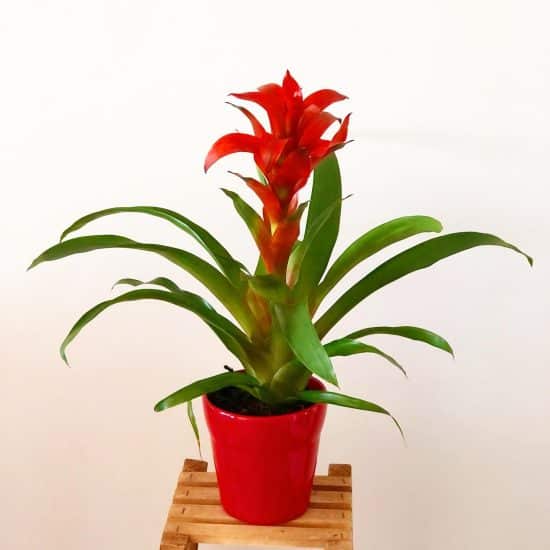
Guzmania lingulata is an epiphyte, which means it lives on trees in the wild, soaking up nutrients and moisture from its lofty perch. So when you bring it indoors, it feels right at home with just a little bright, indirect light — no heavy-duty soil tending needed here.
In the wild, this flashy plant plays a vital role in the ecosystem, offering shelter to small critters, such as tree frogs and salamanders, and luring in pollinators with its colorful bracts.
Fun fact: Despite its fiery reputation, this plant was actually named after Spanish naturalist Anastasio Guzman, a celebrated bromeliad collector and cataloguer. So, while it may look like the embodiment of a blazing star, its true namesake lies in the passion and dedication of a botanical aficionado. Lingulata means “tongue” and refers to the plant’s leaf shape.
Light
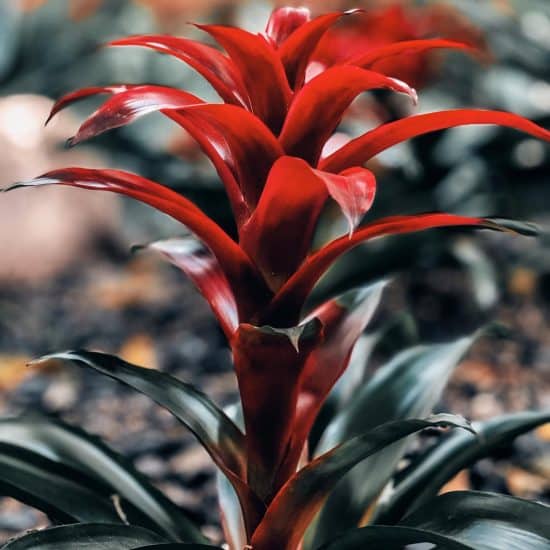
In bright natural sunlight is where your Guzmania lingulata will feel most at home. Place it near an east- or west-facing window to provide it with adequate light. Your plant might survive a few weeks in low light, but the long-term goal is to give it bright conditions. Too much harsh direct sunlight, however, is a no-go. This can lead to a burnt and unhappy plant.
If your scarlet star isn’t getting enough light, its green leaves will become dull or faded. Growth may also slow down or be minimal. In such cases, your plant might reach out for brighter light, making it look leggy and less compact. To fix this, simply move your plant to a spot with more natural light or supplement with a grow light.
On the other hand, excessive light may scorch your scarlet star’s green leaves, leading to brown or yellow spots, and their edges might become brittle and curl. If you spot these signs, it’s time to move your plant to a slightly shadier spot or use a sheer curtain to filter the sunlight.
Our lighting tips:
- Choose east- or west-facing windows for the ideal bright light.
- Your plant can tolerate low light for short periods, but it’s not a long-term solution.
- Keep your scarlet star away from direct, hot sun to prevent burning or scorching of its leaves.
Water
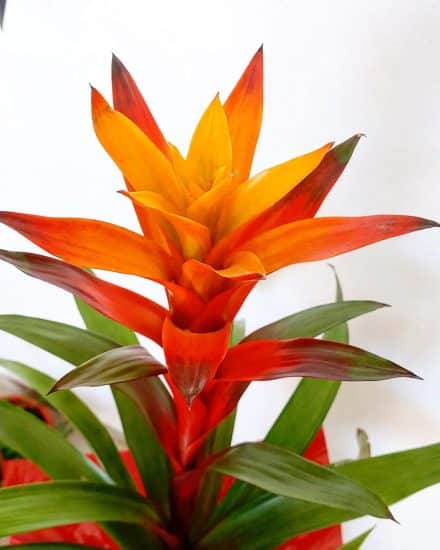
Like other bromeliad plants, your scarlet star has a special feature called a flower cup (sometimes called a vase or urn), where it collects water. To keep your plant happy, simply fill the flower cup with an inch or two of water, but be extra careful not to overfill it. Too much water can cause root rot.
You can also water the soil — just make sure the pot has good drainage, and wait a while before watering again. In the cooler, darker winter months, cut back on watering so your plant doesn’t get too soggy.
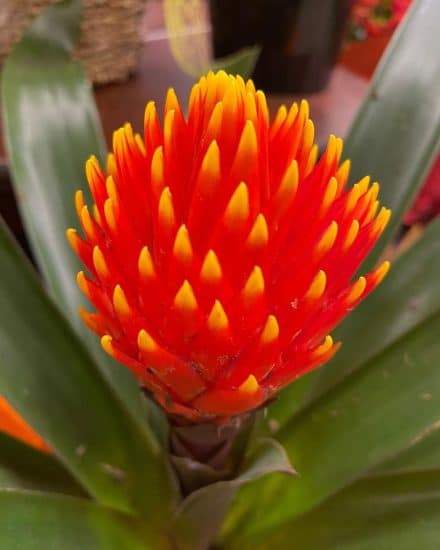
If the water from your tap has high concentrations of soluble salts, it’s probably best to use filtered water for your scarlet star plant instead. Too much salt is bad for the plant’s roots and prevents proper nutrient uptake. If you use a salt-based water softener, find another water source.
If you see the shiny green leaves curling up or your plant looking wilted and sad, that’s a pretty good indication your scarlet star needs more water. Increase your watering frequency and remove any dying leaves.
If you notice yellowing leaves, mushy stems, or waterlogged soil, your plant might be getting a bit more water than it needs. In this case, let the potting soil dry out before watering again.
Temperature and Humidity
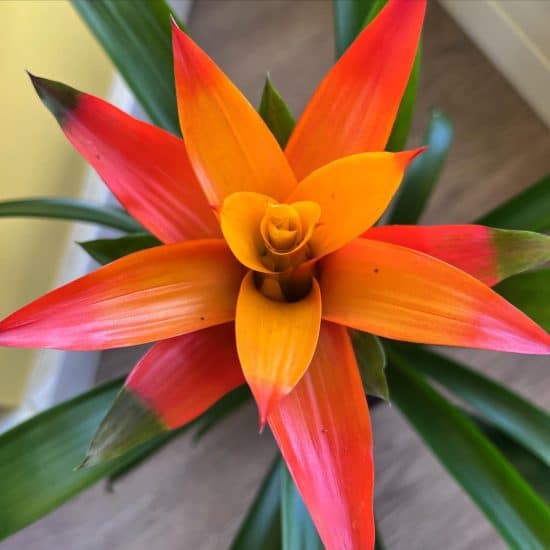
Guzmania lingulata enjoys warm temperatures of 65-80°F (18-27°C), similar to what most people find comfortable in their homes. However, be cautious of cold drafts from windows, vents, or doors. Exposure to extreme high or low temperatures can damage the plant.
Although scarlet star can manage in the drier air of most homes, it prefers high humidity levels of 50%-70%. Brown leaf tips can be a sign that the humidity is too low. To increase humidity, install a humidifier nearby or place the plant on a tray of pebbles filled with water.
(Grouping plants together can also help increase the moisture in the air through a process called transpiration.)
Our temperature and humidity tips:
- Keep Guzmania lingulata in comfortable room temperatures of 65-80°F (18-27°C), avoiding cold drafts and excessive heat.
- Aim for humidity of 50%-70% for optimal growth, adjusting as needed based on leaf conditions.
- Use a humidifier or pebble tray, or group plants together to maintain ideal humidity levels.
Soil and planting
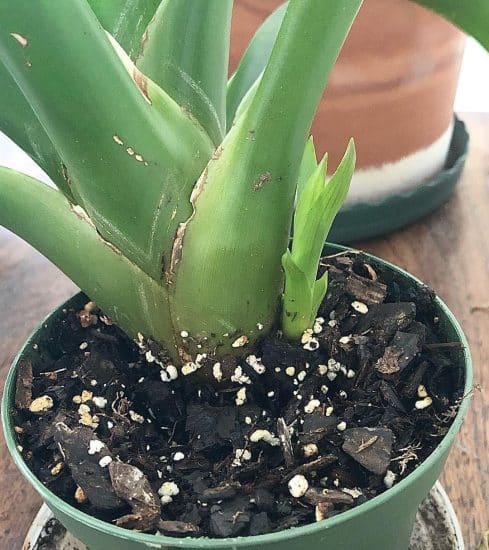
As an epiphyte, Guzmania lingulata needs excellent drainage. Make sure the pot you keep it in has plenty of drainage holes. It may help to plant it in orchid potting soil, such as fir bark, a cymbidium (orchid) mix, or a combination of fir bark and coco coir.
Fertilizing isn’t necessary for bromeliads like scarlet star, but if you really want to, use a balanced water-soluble fertilizer specifically formulated for bromeliads or air plants. An all-purpose orchid food at half strength could also work.
Spray the fertilizer onto the foliage and add a little to the surface of the growing medium. Fertilize only in spring and summer.
Using too much fertilizer can cause a range of issues for your Guzmania lingulata. Symptoms of over-fertilizing include burnt leaf tips, yellowing leaves, and weak growth. To fix this, flush the soil with water to remove excess fertilizer and reduce the amount of fertilizer you use in the future.
Propagation
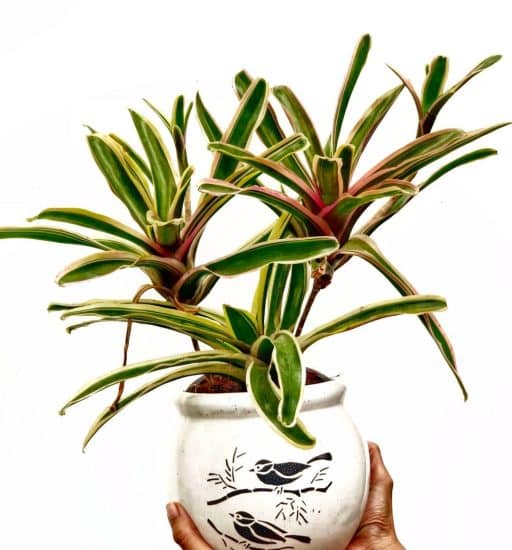
Bromeliads are monocarpic, meaning they flower only once and then die. The good news, though, is that they produce pups before they go, so your scarlet star won’t fully fade away. Here’s how you can propagate your Guzmania lingulata’s pups.
- Wait for the perfect moment before separating your Guzmania lingulata. Keep an eye out for when the mother plant’s flower is spent and the pups are nice and plump. That’s your cue that they’re ready to start their own journey.
- Gently remove the plant from its pot. Find where the pups attach to the mother plant beneath the soil, and using sterilized shears, gently cut to separate them.
- Okay, so you’ve got your pups; now what? You can either plant your scarlet star plants in a well-draining potting mix or wrap them up in coconut coir and secure them to a piece of bark or driftwood. Either way works like a charm — the choice is yours!
- It might take up to three years for your new scarlet star bromeliads to bloom, but trust us, it’s totally worth the wait!
Common Issues
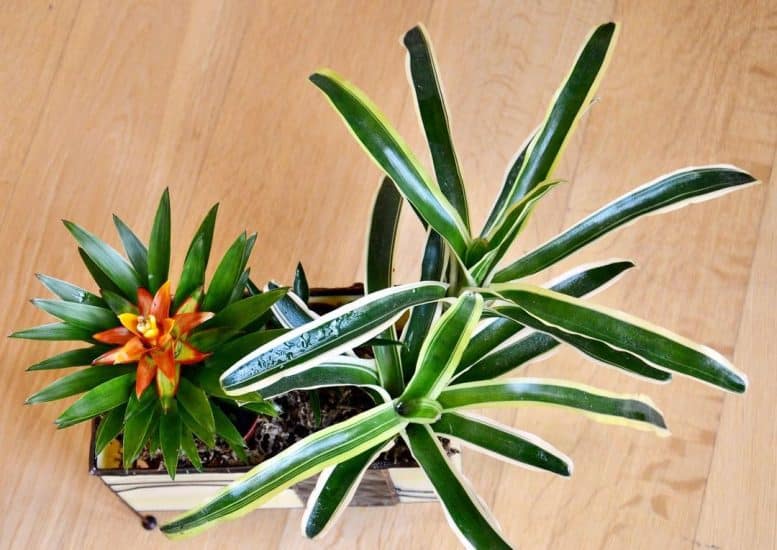
There’s nothing more frustrating than finding brown spots or noticing that your beautiful scarlet star bromeliad, sometimes referred to as orange star or Caraguata lingulata, just isn’t blooming.
Brown Leaf Tips
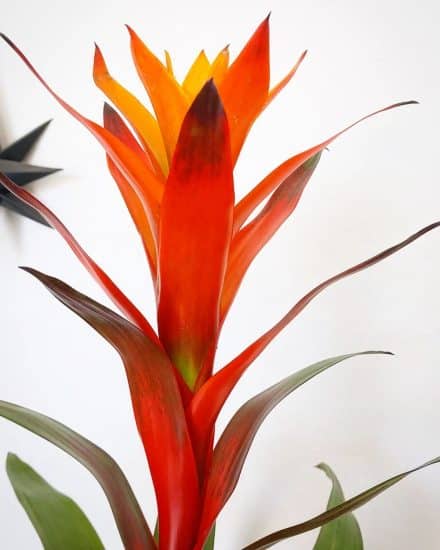
If the tips of your Guzmania lingulata’s leaves turn brown, odds are it’s a humidity issue.
The good news is, it’s super easy to fix! Just place a tray of water or a humidifier nearby to create the perfect spa-like atmosphere your scarlet star bromeliad loves. With a little tender loving care, those brown tips will be history!
Not Blooming
A lack of bloom could simply mean that your Guzmania lingulata is young, but it could also indicate a lack of proper lighting or nutrients, or that your scarlet star is unhappy with its environment. To find the root of the problem (pun intended), ensure that your plant has enough bright light year-round, the right level of moisture, and the ideal temperature.
If your plant’s conditions are ideal and it’s still not blooming, treat your plant to a balanced water-soluble fertilizer specifically designed for bromeliads. Be sure to follow the instructions and recommended frequency.
Pests and diseases
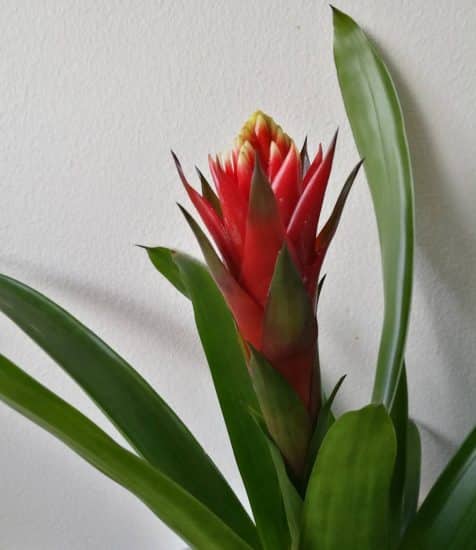
Leaf Spots
Spots that look like bleaching could indicate too much sun. But a scarlet star in mild lighting exhibiting small, discolored circles on the leaves, ranging from yellow to brown, or even black, can signal fungal infections or bacterial issues. If you don’t nip it in the bud, these spots can lead to bigger problems, like leaf loss and plant death.
So, to figure out what’s causing the leaf spots, take a closer look for any signs of mold or mildew growth. If you see any, you’re most likely dealing with a fungal infection. On the other hand, if the spots come with a foul smell or blackening leaves, then it could be a bacterial problem.
Start by removing all affected leaves using sterilized scissors or a sharp knife. After that, apply a fungicide or bactericide according to the product’s instructions, making sure to follow the label directions and precautions.
To prevent leaf spots in the future, just remember to follow our Guzmania care guidelines. Keep things like air circulation, humidity levels, and watering in check. And, of course, always be on the lookout for any signs of leaf spots so you can take action as soon as you spot them.
Scale
Scale insects feed on the plant’s sap, which can lead to weakened plants, yellowing leaves, and stunted growth. These insects are small, round, and flat, and their color ranges from brown to white or even pink.
To identify scale, look for small, shield-like insects on the leaves and stems. You might also notice a sticky residue, called honeydew, that can cause sooty mold to grow.
So, how do you get rid of these pesky scale insects?
First, remove any heavily infested leaves or stems. Then, use a soft cloth or cotton swab dipped in rubbing alcohol to wipe the remaining insects off your plant. It may be tedious work, but the effort is well worth it to save your plant. For severe infestations, consider using an insecticidal soap or horticultural oil — just make sure to follow the product’s instructions.
Conclusion
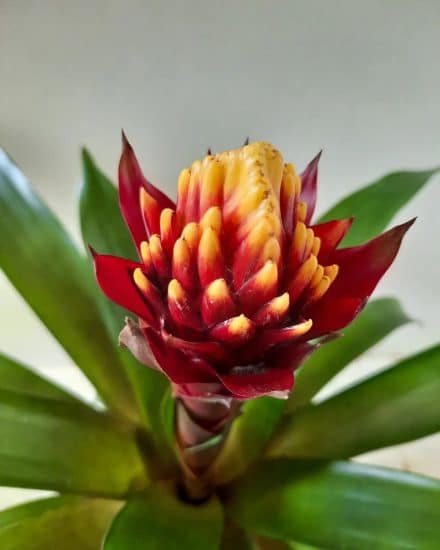
That’s a wrap for our Guzmania lingulata care guide! With all the information you need to keep your scarlet star healthy and vibrant, you’re now ready to add this stunning tropical plant to your indoor garden.
Guzmania lingulata care summary:
- Provide bright, indirect light, and avoid direct sunlight to prevent scorching.
- Fill the natural cup in the center of the plant with 1-2 inches of water, and water the growing medium sparingly.
- Keep the temperature at 65-80°F (18-27°C) and target humidity levels of 50%-70%.
- Use well-draining potting mix, such as orchid bark or a cymbidium mix, and repot every 2-3 years.
- Fertilize in spring and summer, if desired, with a specialized bromeliad or air plant fertilizer.
We hope this guide has helped you understand how to care for your Guzmania lingulata and inspired you to add this tropical gem to your indoor plant collection. If you have any questions or need further assistance, please feel free to reach out to us.
Remember to share this guide with fellow plant enthusiasts and happy growing!
FAQ
Is a Guzmania plant indoor or outdoor?
Guzmania lingulata can be both an indoor and outdoor plant. While it originally hails from the verdant rain forests of Central and South America, this epiphytic wonder has adapted remarkably well to indoor environments.
When planted indoors, it needs a touch of bright, indirect sunlight and doesn’t require heavy-duty soil tending. For outdoor planting, just ensure it has some shade and protection from direct sunlight, especially in the afternoon.
Why is it called scarlet star?
The name has everything to do with its stunning appearance. With fiery, bold-colored flower heads in shades of red, orange, yellow, pink, and plum, it’s a true spectacle! These captivating hues, along with the star-like pattern that the plant forms, inspired its nickname.

